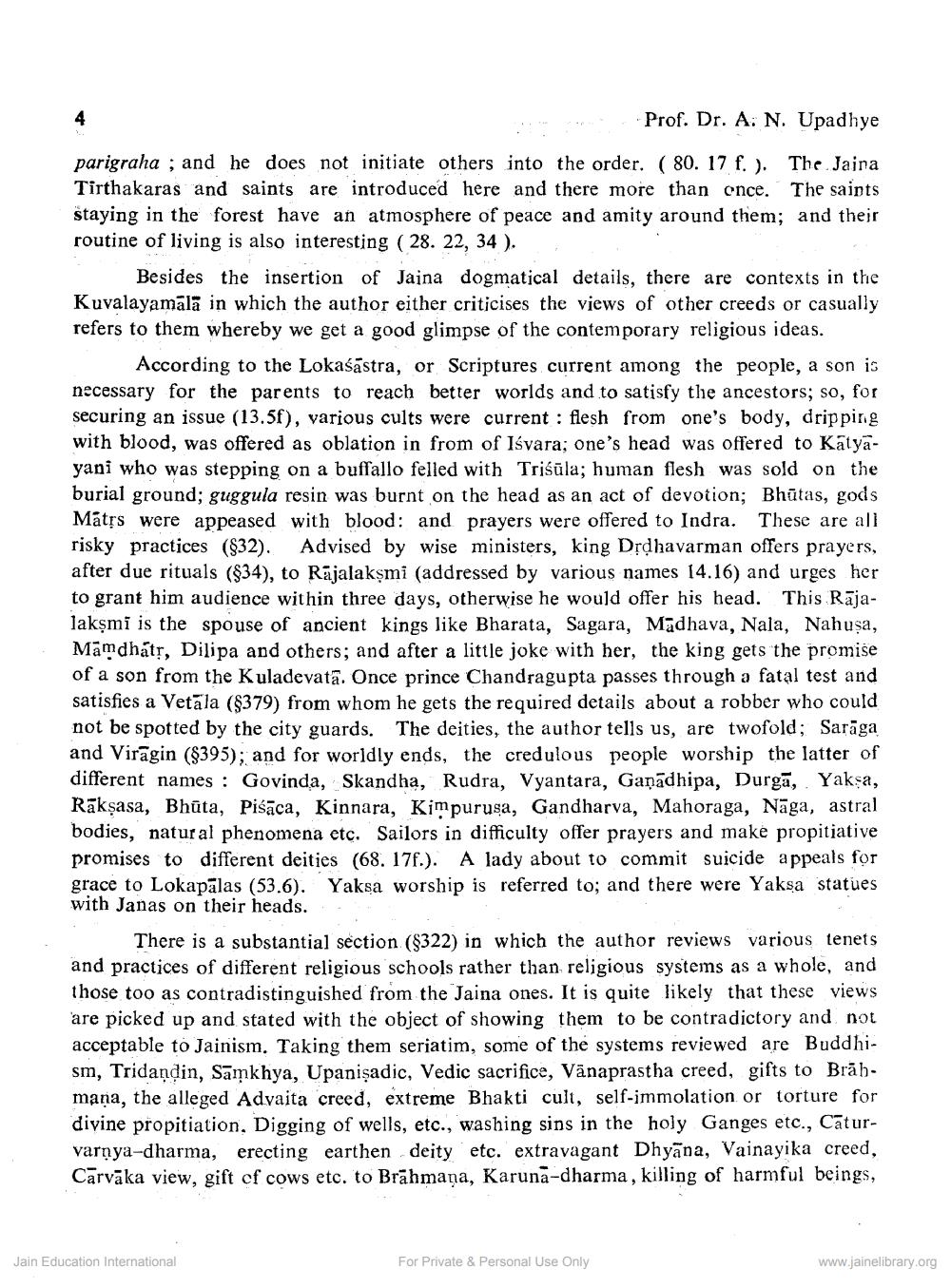Book Title: Religious background of Kuvalayamala Author(s): A N Upadhye Publisher: Z_Jinvijay_Muni_Abhinandan_Granth_012033.pdf View full book textPage 4
________________ Prof. Dr. A. N. Upadhye parigraha ; and he does not initiate others into the order. ( 80. 17 f.). The Jaina Tirthakaras and saints are introduced here and there more than once. The saints staying in the forest have an atmosphere of peace and amity around them; and their routine of living is also interesting ( 28. 22, 34). Besides the insertion of Jaina dogmatical details, there are contexts in the Kuvalayamala in which the author either criticises the views of other creeds or casually refers to them whereby we get a good glimpse of the contemporary religious ideas. According to the Lokaśāstra, or Scriptures current among the people, a son is necessary for the parents to reach better worlds and to satisfy the ancestors; so, for securing an issue (13.5f), various cults were current : flesh from one's body, dripping with blood, was offered as oblation in from of Iśvara; one's head was offered to Katyayani who was stepping on a buffallo felled with Triśūla; human flesh was sold on the burial ground; guggula resin was burnt on the head as an act of devotion; Bhūtas, gods Mātřs were appeased with blood: and prayers were offered to Indra. These are all risky practices ($32). Advised by wise ministers, king Drồhavarman offers prayers, after due rituals (834), to Rajalakṣmi (addressed by various names 14.16) and urges her to grant him audience within three days, otherwise he would offer his head. This Rajalakṣmi is the spouse of ancient kings like Bharata, Sagara, Madhava, Nala, Nahusa, Māmdhats, Dilipa and others; and after a little joke with her, the king gets the promise of a son from the Kuladevata. Once prince Chandragupta passes through a fatal test and satisfies a Vetāla ($379) from whom he gets the required details about a robber who could not be spotted by the city guards. The deities, the author tells us, are twofold; Sarāga and Virāgin ($395); and for worldly ends, the credulous people worship the latter of different names : Govinda, Skandha, Rudra, Vyantara, Ganadhipa, Durgā, Yaksa, Rākşasa, Bhūta, Pisaca, Kinnara, Kimpurusa, Gandharva, Mahoraga, Nāga, astral bodies, natural phenomena etc. Sailors in difficulty offer prayers and make propitiative promises to different deities (68. 177.). A lady about to commit suicide appeals for grace to Lokapālas (53.6). Yaksa worship is referred to; and there were Yaksa statues with Janas on their heads. There is a substantial section (8322) in which the author reviews various tenets and practices of different religious schools rather than religious systems as a whole, and those too as contradistinguished from the Jaina ones. It is quite likely that these views are picked up and stated with the object of showing them to be contradictory and not acceptable to Jainism. Taking them seriatim, some of the systems reviewed are Buddhism, Tridandin, Samkhya, Upanişadic, Vedic sacrifice, Vānaprastha creed, gifts to Brāh. mana, the alleged Advaita creed, extreme Bhakti cult, self-immolation or torture for divine propitiation, Digging of wells, etc., washing sins in the holy Ganges etc., Caturvarnya-dharma, erecting earthen deity etc. extravagant Dhyana, Vainayika creed, Carvāka view, gift cf cows etc. to Brāhmana, Karuna-dharma , killing of harmful beings, Jain Education International For Private & Personal Use Only www.jainelibrary.orgPage Navigation
1 2 3 4 5 6
